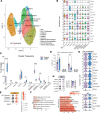Mild/asymptomatic COVID-19 in unvaccinated pregnant mothers impairs neonatal immune responses
- PMID: 37698937
- PMCID: PMC10629812
- DOI: 10.1172/jci.insight.172658
Mild/asymptomatic COVID-19 in unvaccinated pregnant mothers impairs neonatal immune responses
Abstract
Maternal SARS-CoV-2 infection triggers placental inflammation and alters cord blood immune cell composition. However, most studies focus on outcomes of severe maternal infection. Therefore, we analyzed cord blood and chorionic villi from newborns of unvaccinated mothers who experienced mild/asymptomatic SARS-CoV-2 infection during pregnancy. We investigated immune cell rewiring using flow cytometry, single-cell RNA sequencing, and functional readouts using ex vivo stimulation with TLR agonists and pathogens. Maternal infection was associated with increased frequency of memory T and B cells and nonclassical monocytes in cord blood. Ex vivo T and B cell responses to stimulation were attenuated, suggesting a tolerogenic state. Maladaptive responses were also observed in cord blood monocytes, where antiviral responses were dampened but responses to bacterial TLRs were increased. Maternal infection was also associated with expansion and activation of placental Hofbauer cells, secreting elevated levels of myeloid cell-recruiting chemokines. Moreover, we reported increased activation of maternally derived monocytes/macrophages in the fetal placenta that were transcriptionally primed for antiviral responses. Our data indicate that even in the absence of vertical transmission or symptoms in the neonate, mild/asymptomatic maternal COVID-19 altered the transcriptional and functional state in fetal immune cells in circulation and in the placenta.
Keywords: COVID-19; Cellular immune response; Immunology; Innate immunity; Monocytes.
Figures





Similar articles
-
A systematic review of pregnant women with COVID-19 and their neonates.Arch Gynecol Obstet. 2021 Jul;304(1):5-38. doi: 10.1007/s00404-021-06049-z. Epub 2021 Apr 2. Arch Gynecol Obstet. 2021. PMID: 33797605 Free PMC article.
-
Single-nucleus transcriptional profiling of the placenta reveals the syncytiotrophoblast stress response to COVID-19.Am J Obstet Gynecol. 2025 Apr;232(4S):S160-S175.e7. doi: 10.1016/j.ajog.2025.01.028. Am J Obstet Gynecol. 2025. PMID: 40253079
-
Placental transfer of SARS-CoV-2 antibodies in mother-neonate pairs: a prospective nested cohort study.BMC Infect Dis. 2025 Jul 1;25(1):875. doi: 10.1186/s12879-025-11225-6. BMC Infect Dis. 2025. PMID: 40597729 Free PMC article.
-
The immune landscape of fetal chorionic villous tissue in term placenta.Front Immunol. 2025 Jan 13;15:1506305. doi: 10.3389/fimmu.2024.1506305. eCollection 2024. Front Immunol. 2025. PMID: 39872537 Free PMC article.
-
Rapid, point-of-care antigen tests for diagnosis of SARS-CoV-2 infection.Cochrane Database Syst Rev. 2022 Jul 22;7(7):CD013705. doi: 10.1002/14651858.CD013705.pub3. Cochrane Database Syst Rev. 2022. PMID: 35866452 Free PMC article.
Cited by
-
Maternal SARS-CoV-2 impacts fetal placental macrophage programs and placenta-derived microglial models of neurodevelopment.J Neuroinflammation. 2024 Jun 25;21(1):163. doi: 10.1186/s12974-024-03157-w. J Neuroinflammation. 2024. PMID: 38918792 Free PMC article.
-
Maternal SARS-CoV-2 infection in pregnancy disrupts gene expression in Hofbauer cells with limited impact on cytotrophoblasts.PLoS Pathog. 2024 Feb 7;20(2):e1011990. doi: 10.1371/journal.ppat.1011990. eCollection 2024 Feb. PLoS Pathog. 2024. PMID: 38324589 Free PMC article.
-
Immunological and microbial shifts in the aging rhesus macaque lung during nontuberculous mycobacterial infection.mBio. 2024 Jun 12;15(6):e0082924. doi: 10.1128/mbio.00829-24. Epub 2024 May 21. mBio. 2024. PMID: 38771046 Free PMC article.
References
-
- CDC. Covid Data Tracker. Pregnancy Data. https://covid.cdc.gov/covid-data-tracker/#pregnancy-data. Accessed September 5, 2023.
Publication types
MeSH terms
Substances
Grants and funding
LinkOut - more resources
Full Text Sources
Medical
Miscellaneous

